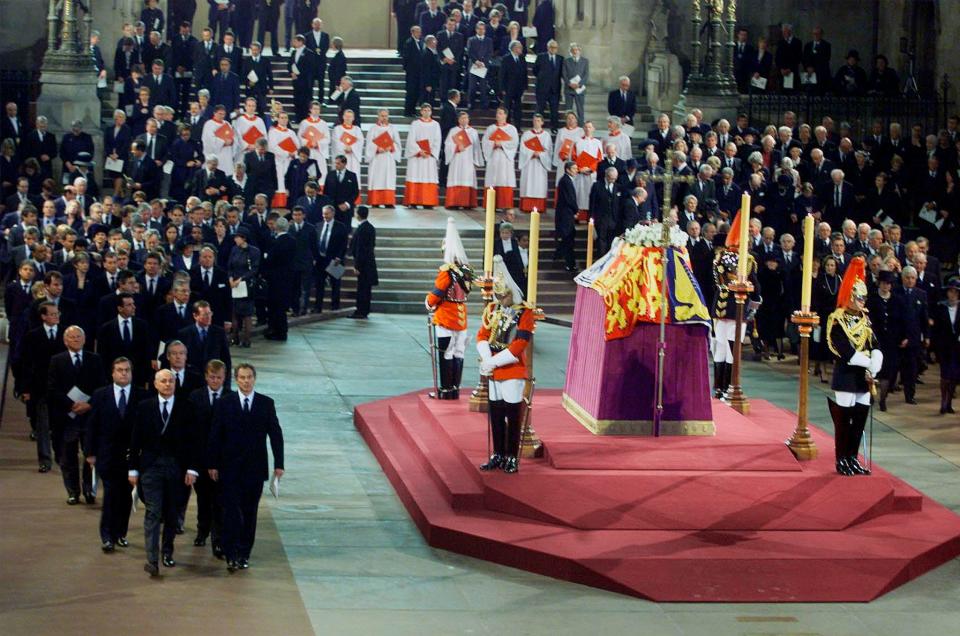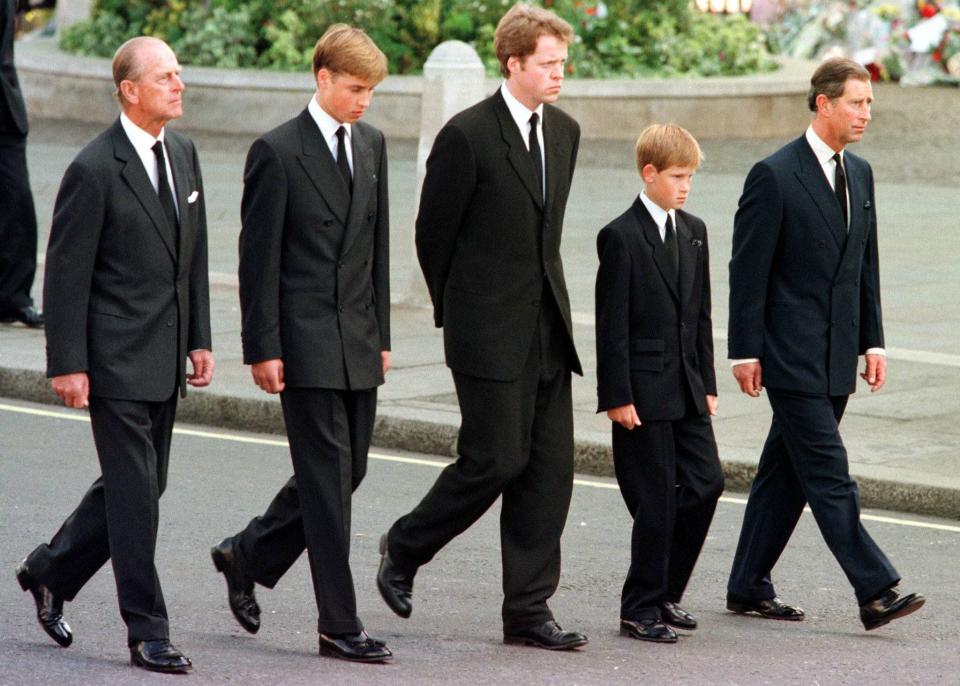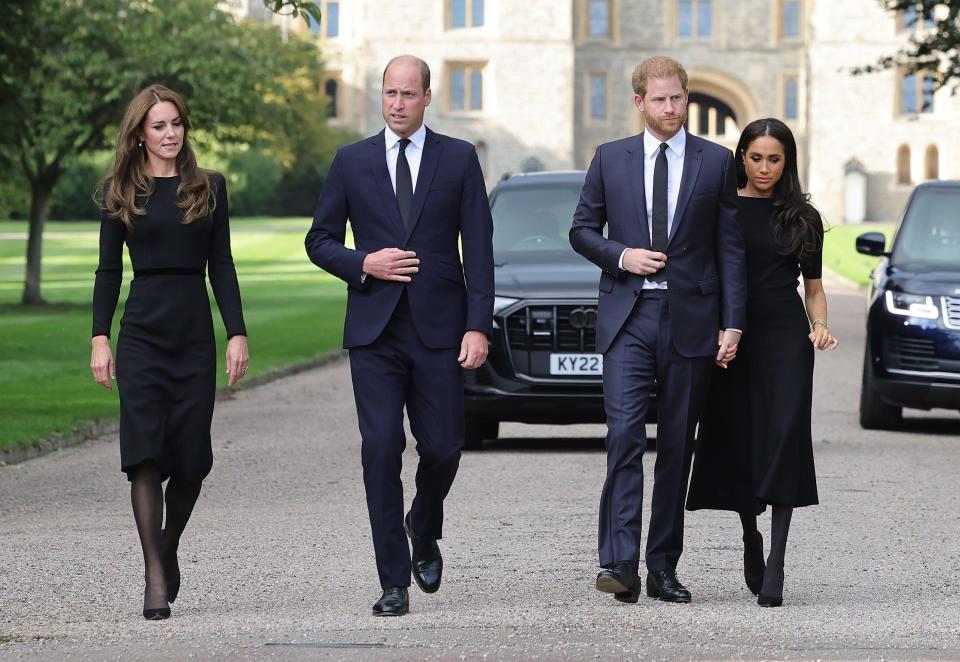Survival of the monarchy: Why Queen Elizabeth II's funeral is more than just ceremony
- Oops!Something went wrong.Please try again later.
- Oops!Something went wrong.Please try again later.
- Oops!Something went wrong.Please try again later.
- Oops!Something went wrong.Please try again later.
- Oops!Something went wrong.Please try again later.
When Queen Elizabeth II is laid to rest next week, the United Kingdom will witness, for the first time in nearly 60 years, a magnificent state funeral designed in part by the queen to unite her squabbling family and divided subjects while helping ensure the monarchy survives another century.
As Monday's historic funeral approaches, it looks as if it might be working. It is not such a surprise: The royal Windsors have long known this is what royal state funerals are supposed to be in a constitutional monarchy.
The queen, who died Sept. 8 in Scotland at age 96 after 70 years on the throne, was widely considered the glue holding the U.K. together. She was also the most canny of her Windsor ancestors about using ceremony and splendor to bond the monarchy and the people who pay for it.
As Peter Morgan, the British writer and creator of the Oscar-winning 2006 film "The Queen" and Netflix's "The Crown," once told USA TODAY, "The royals are a very sophisticated survival machine."
Indeed. Now we'll see those skills on full display. Monday's funeral will be very much like what has already happened in the 10 days leading up to it – only even grander.
Who else has had a state funeral?
Not since 1965, for former Prime Minister Winston Churchill, has Britain mounted a "state" funeral, which is usually reserved for monarchs, with exceptions for distinguished figures such as Churchill, the queen's first prime minister of her reign.
State funerals for monarchs encompass about 10 days of moving ceremonies and rituals, some of them ancient, some of them more recent, but exquisite and precise in a manner the British have famously perfected over the centuries.
Castles and crowns: What did Queen Elizabeth leave behind in the House of Windsor's estate
In coming days we will see and hear the clip-clop of horses pulling a gun carriage with a Royal Standard-draped coffin topped with the Imperial State Crown. There are days of lying in state, hundreds of thousands waiting hours to file past to pay respects. We'll see solemn, slow processions of family members, ranks of royal troops, multiple military bands. There will be choirs singing, priests praying, guns firing, bells tolling. And many, many horses.
Westminster Abbey, where royals traditionally have been married, crowned and buried for centuries, will be stuffed with the great and good of the U.K. and the world. In another first for the abbey, the queen's funeral will be the first for a reigning sovereign since 1760 and the death of one of her remote ancestors, King George II.
Most of this will be televised except the final moment, when the queen's oak coffin is lowered below the floor of St. George's Chapel at Windsor Castle to be interred in the tiny chapel where she will join her parents, sister and husband.
After the funeral, planning will begin for the coronation of the new King Charles III, 73, which also will take place at Westminster Abbey, probably in spring or summer 2023. Coronations take a long time to organize: Elizabeth became queen in February 1952 but was not crowned until June 1953.
How the queen helped plan her own funeral
Royal funerals are planned decades in advance by governments and the crown, and the plans are updated regularly. The monarch plays a crucial role in deciding details. The choice of flowers in the wreath on her coffin, the music and prayer selections, even the bespoke design of the Royal Hearse (lots of glass and inside light so the casket can be seen even at night), were all decisions made by the queen.
The last state funeral for a monarch was in 1952 for the queen's father, King George VI, who died at 56 of lung cancer. There have been only four such funerals since 1901, including the funerals of the queen's grandfather, George V, in 1936; her great-grandfather, Edward VII, in 1910; and her great-great grandmother, Queen Victoria, in 1901.
Other recent royal funerals were "ceremonial" funerals, not state funerals, even if they were covered by the media as if they were. The queen's husband, Prince Philip, died at age 99 in April 2021 during the coronavirus pandemic, so the ceremonies were much smaller in terms of mourners. But the no-fuss prince, who was married to Elizabeth for 73 years, wanted a not-too-much-fuss funeral and planned it that way.
The queen's mother, Queen Elizabeth the Queen Mother, was the consort of a former sovereign, not the sovereign, so when she died in 2002 at age 101, her funeral was grand but not officially a state funeral. Still, she was a much-loved figure, and more than 200,000 people stood in line to file past her casket in Westminster Hall.

How Princess Diana's funeral helped a grieving nation
And Princess Diana's funeral in September 1997, hastily arranged in the aftermath of her shocking death in a car crash in Paris, wasn't a state funeral in part because the then-Princess of Wales was no longer a member of the royal family: She and Prince Charles, then the Prince of Wales, were divorced the year before.
Yet Diana's unforgettable funeral – millions weeping in the streets of London, the heartbreaking march of her two young sons behind her casket, Elton John singing "Candle in the Wind" in Westminster Abbey, her brother's eulogy greeted by thunderous applause – was a memorable mashup of tradition and royal magic, reflecting the lost princess herself. "A unique funeral for a unique person," as Buckingham Palace said at the time.
Witnessing that funeral helped a nation prostrate with grief recover. It helped a queen initially attacked for seeming coldness in the wake of Diana's death be reconciled with her people. It helped reinforce the unwritten British constitution's arrangement of how the head of state (the sovereign) and the head of government (the prime minister) interact. And it helped a family reeling from the tragedy to find its footing and move on.

Already we have seen the queen's feuding grandsons, Prince William, 40, the new Prince of Wales, and Prince Harry, 38, reunited in grief, at least for now: They appeared together with their wives, greeting well-wishers outside Windsor Castle on Saturday and marching together in the procession as the queen's casket was taken to Westminster Hall Wednesday for four days of lying in state.
In restive Scotland, five days of ceremonies showed that Elizabeth was a much-loved Queen of Scots, too, as hundreds of thousands turned out to weep, watch her funeral cortege, file past her and bid her farewell as her casket was flown to London Tuesday night.
These scenes led political observers to wonder whether there will be more or less support among Scots for independence from the United Kingdom; the current political leadership of Scotland wants another referendum on the question. Royal observers wonder whether Scots' affection for the queen will apply to her son, King Charles III, and to the monarchy itself, as anti-royalists, or republicans as they are known, proceed cautiously in the wake of the queen's death.

So a sovereign's funeral is not just a family event, although it is that. It's a state event, organized by the state, featuring participation by branches of the state (the government, Parliament, the military, the Civil Service, the Crown), and paid for by the state – that is, the taxpayers.
It is designed to be remembered, even those that took place before radio, television or Twitter. In the first half of the 20th century, those generations of Britons had actually witnessed multiple state funerals for sovereigns, and spoke of them long into the second half of the 20th century.
But Queen Elizabeth II upended all actuarial expectations by living and reigning for so long. Her funeral, taking place when there are so few living Britons who remember 1952, will be a novel experience for millions and at the same time a point of pride that Great Britain can still impress the world.
At least, that is no doubt what the queen hoped.
This article originally appeared on USA TODAY: Queen Elizabeth II funeral plans more than ceremony unites UK

